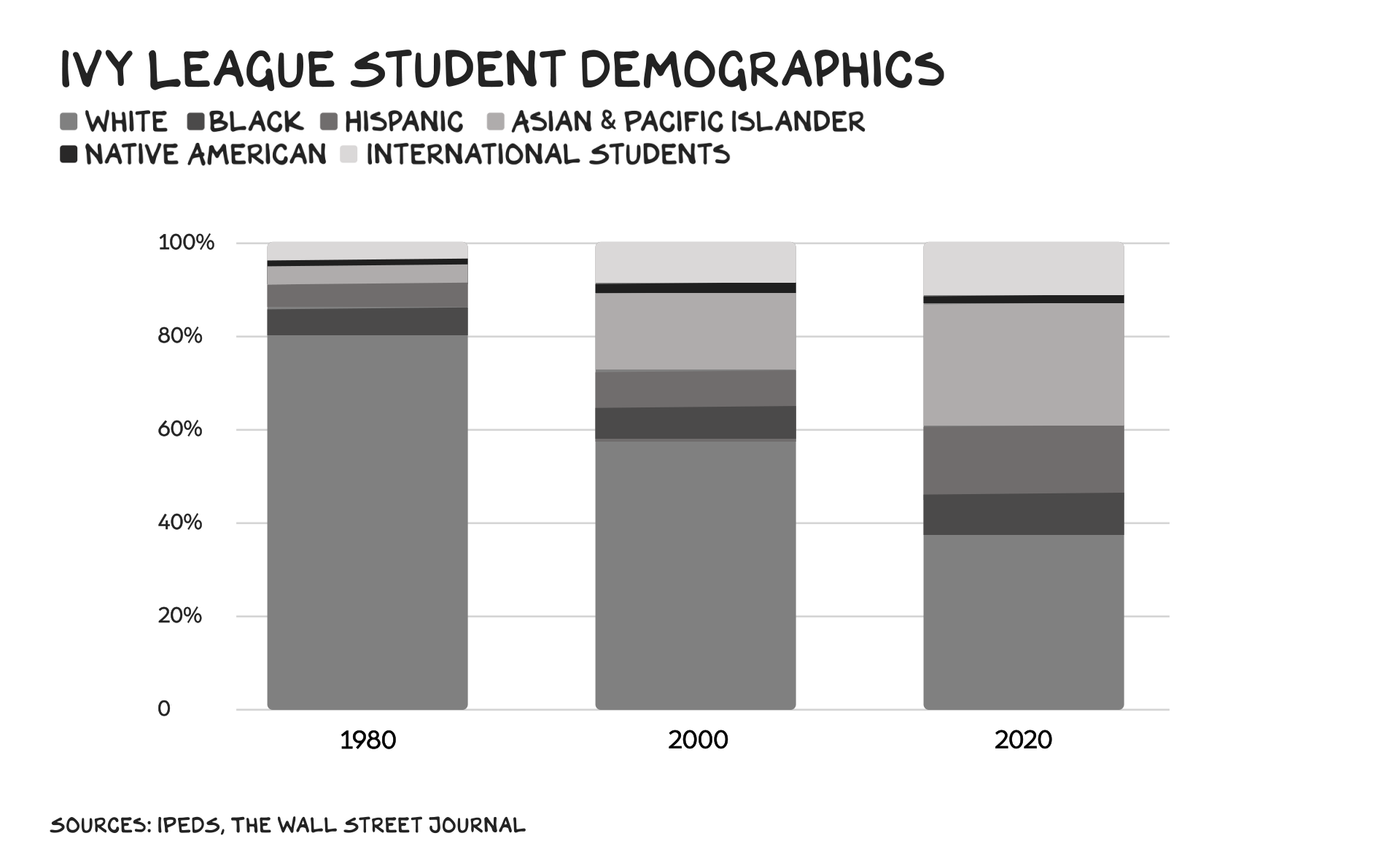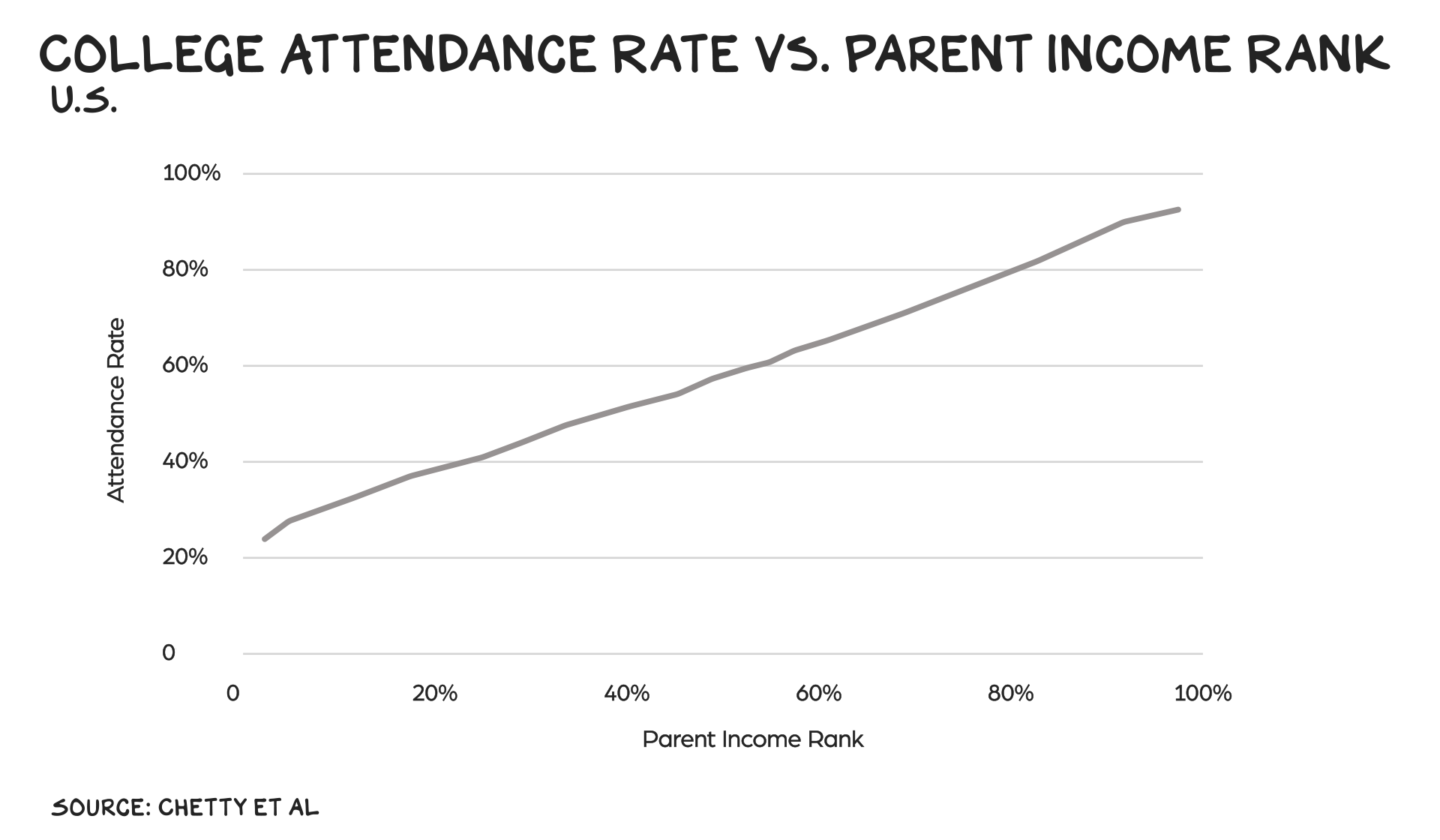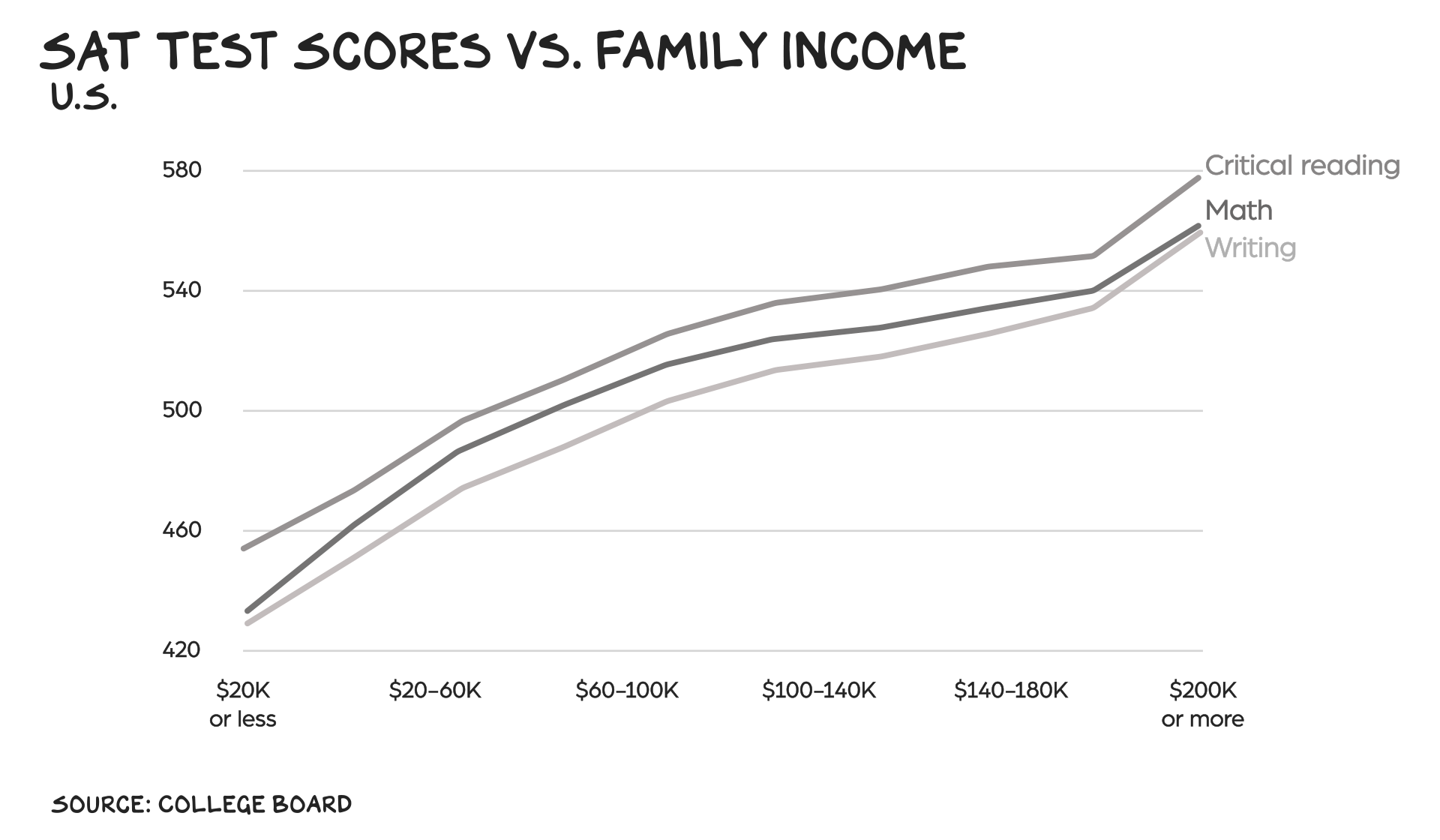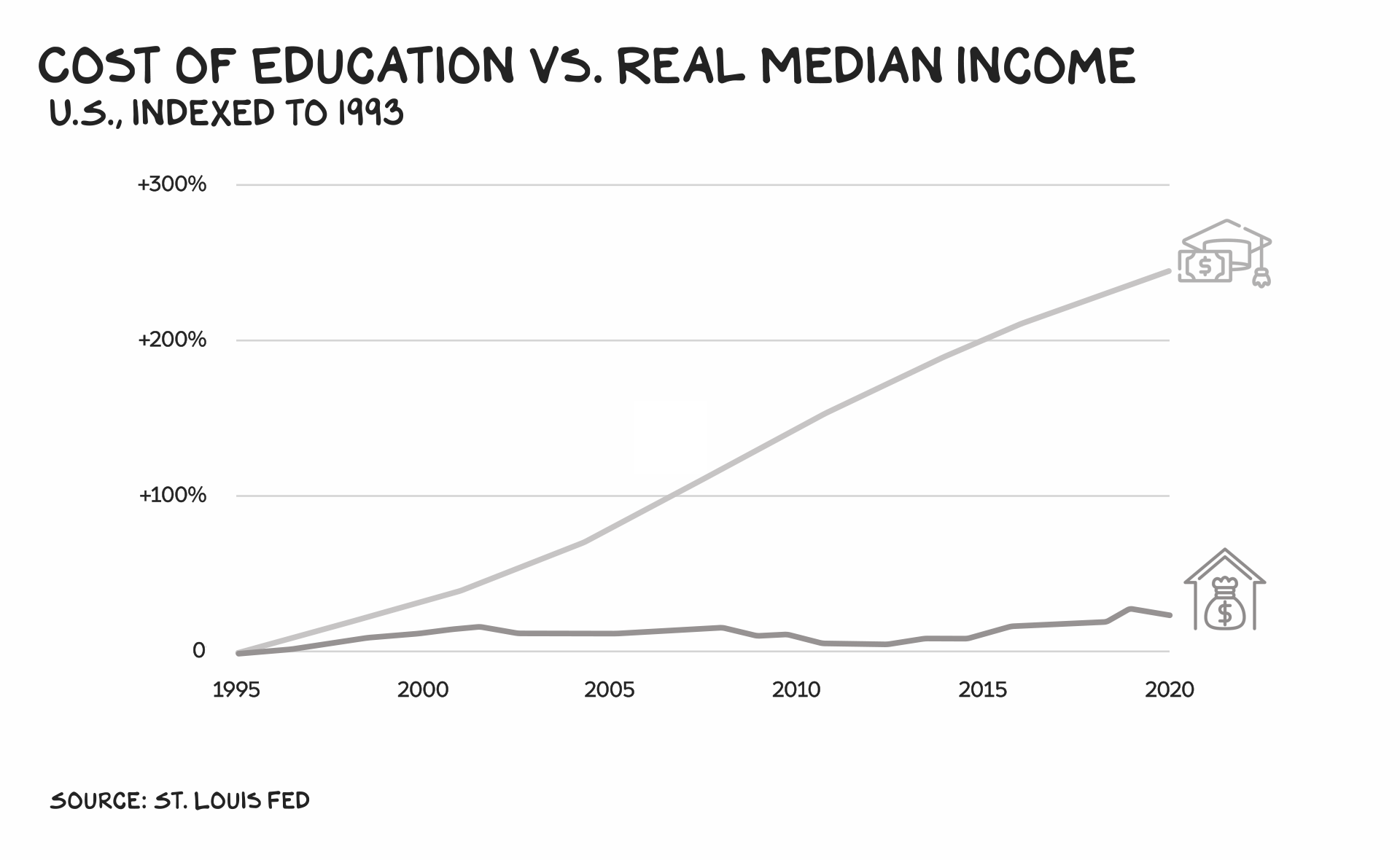
Super Drug
What if there was a drug that extended life, made you happier, healthier, and wealthier, and strengthened your relationships? The good news: It exists. The bad news: It’s being needlessly hoarded.
This drug is higher education. America is the world’s premier source, producing the compound at a purity no other manufacturer can rival. Harvard, for example, quadruples the patient’s income. It also dramatically increases their odds of becoming president. Millions come to the U.S. to access this drug. In a rational world, we’d be making as much of it as possible. Instead, we sequester it behind ivy-covered walls and sky-high tuitions. And for centuries, we prescribed it almost exclusively to white people.
15
In 1960 the Black student population across Harvard, Yale, and Princeton was 15. That’s 15 people, not 15%. In 1965, President Johnson made the case for doing something about it: “You do not take a person who, for years, has been hobbled by chains and liberate him, bring him up to the starting line of a race, and then say, ‘You are free to compete with all the others.’” Subsequently, affirmative action has helped reallocate elite higher education more equitably: Between 1980 and 2020, the non-white Ivy League student population went from 14% to 50%.

Affirmative action has been controversial, and disputes about race-conscious admissions regularly reach the U.S. Supreme Court. This week the Court dismantled affirmative action, determining it unconstitutional to consider race in university admissions.
I believe this is the right answer (but the wrong question … more on that in a moment). I’m not alone in this view. Affirmative action is broadly unpopular. In the U.S., 74% of people don’t believe race should be used as even a minor deciding factor in college admissions. California ended affirmative action at public universities in 1996, and in 2020 voters rejected a measure to reinstate it by 14 percentage points. The benefits of race-based affirmative action have expired. (See above: The changed racial makeup at Ivy League schools.) To be clear, race is still a powerful force in American society, but it lags a more sweeping agent: money.
$$$
Students from the top family-income bracket score higher on standardized tests and are far more likely to go to college. At Harvard, 71% of Black, Latino, and Native American students come from college-educated homes with family incomes above the national median. Reshuffling elites, by race, is still elitism.


In a capitalist society, money is increasingly the ultimate determinant of everything. Beyond your college performance, the amount your parents make improves most other outcomes, from teenage birth rates to life expectancy. While it’s true a poor Black kid is disproportionately affected by poverty more than a poor white kid, the more meaningful macro-indicator of their success isn’t race — it’s that they’re poor. Family income isn’t a proxy for inequality, it is inequality. Americans support class-based preferences by 2 to 1. And they work: without looking at race, my alma maters, UCLA and Berkeley, consistently admit the highest percentage of students receiving federal Pell grants. In 2021 the UC system admitted its most racially diverse class ever.
The Court’s ruling has inspired an overdue conversation re legacy admissions. They’re a double-edged sword. It’s wrong that the unimpressive kids of shopping mall developers gain easier admission to the best colleges. Admissions directors know this. But money is the neosporin for their souls — happy alumni are generous alumni and could (in theory) provide the resources to help disadvantaged kids. But that justification is inconsistent with the rising cost and elitism of higher education.
In the past five decades, the price of college has risen 1,600%. Meanwhile, increasingly commonplace sub-10% acceptance rates are viewed as a feature not a bug. Some nuance here: This tuition increase is not evenly distributed, because the richest schools have torrents of money for scholarships. But their artificial limits on supply arbitrage good kids from middle-class families down the cartel chain to schools that charge the same price but don’t offer the same financial aid … or the same certification and experience. A kid from a top-0.1%-income-earning household is 80 times more likely to get into an elite college than a kid from the bottom fifth. College sweatshirts would be more honest if they printed “Caste” above the logo.

Misdirection
The discussion around affirmative action and the emotion it evokes distract from the real issue and culprits. The question facing American higher education is not “Who?” It’s “How Many?” The answer should be … “More.” Specifically, lower cost, increased volume. More kids of color, more middle- and lower-income kids, more trans kids, more men, more women, more legacies, and more international students who pay full freight and become evangelists for the U.S. when they return to their native countries … or stay to run a Nasdaq company. We need to stop finding reasons to divide us and focus on solutions that enrich us. Hoarding a lifesaving drug like this would cause chaos and anger. And it has. Ask any parent of a senior applying to college.
Grand Bargain
The Supreme Court has, accidentally, illuminated a path forward. Striking down Biden’s debt-relief program freed up $500 billion earmarked for higher education. Something with a $500 billion price tag should be for an investment in the future of the country, not a populist bailout. The student debt relief package was an effort to shrink the tumor, but it did nothing to treat the underlying cancer — cost and access. It’s telling that the affirmative action debate is irrelevant to most colleges and college applicants, as they do not have demand that far outstrips supply. That’s the answer, supply.
Here’s my proposal. The federal government should offer the largest 500 public universities (approximately the top third) an average of $1 billion per school (adjusted by size), in exchange for the following commitments. Over the next 10 years:
- Reduce tuition by 2% a year;
- Expand enrollments 6% a year via investments in technology and infrastructure; and
- Increase vocational/certificate programs to 20% of students.
The net result, in 10 years, would be double the freshman seats at half the cost (accounting for inflation) and a step-change in opportunity for kids who do not have the money, skills, or desire to pursue a traditional four-year degree. Nearly 50% of Germans have some sort of vocational certification; in the U.S. it’s 5%. Pro tip: Neither you nor your kid have failed if they don’t get a four-year liberal arts degree.
Note: Spare me the bullshit about an erosion in brand equity if our best universities broaden admissions standards. When I attended UCLA it had a 76% admissions rate, and the brand was outstanding. Scarcity is for luxury brands, not education. Rejectionist Nimbyism is a means of transferring of wealth from young/poor to old/rich: skyrocketing value in existing degrees and houses while the cost for young people to attain their dreams has — in lock step — also skyrocketed.
If we can scale companies 40% per year, then we can expand enrollments at our great public universities 6% per year. The system is ready. Remote learning and utilizing campuses during non-peak periods (summer, nights, weekends) could double capacity. Stop building luxury dorms and lazy rivers. Abandon our obsession with four-year liberal arts degrees — we can continue to produce poets and philosophers, but also plumbers and cybersecurity technicians.
Private
Most elite schools, however, are “private” though, right? Sort of. Even more than most “private” enterprises in the U.S., universities are profoundly entangled with the public purse (why the Supreme Court can tell Harvard how to run admissions). They are non-profits and don’t pay taxes on their endowment income, they are the recipients of billions in government grants, and their students pay tuition with federally subsidized student loans and financial aid. Accordingly, we should revoke the non-profit status of any university that enjoys a $1B+ endowment but isn’t expanding its freshman class size at the same, or greater, rate than population growth. If an organization is growing its endowment (i.e., revenues) but not their service to the commonwealth, there’s a term for that: for-profit.
Debt
Student loan debt is a problem, but it’s not the generation-wide disaster the left claims it is. Most student loan holders have manageable debt (the average payment is about $500 per month, or less than 10% of the median starting salary for a college graduate) which they pay off. That’s how loans work. But we should expand our existing loan forgiveness programs for those who take public service jobs or were affirmatively misled. And we should put schools on the hook for the bad debt they create. If a college’s graduate defaults on their student loans, the college should own 25% of the loss. This would force colleges to either improve the ROI of an education that foots the real economy or stop loaning $200k to kids they know will struggle to pay it back — they have this data. A student loan bailout enables universities to continue growing the tumor with increased prices: yes, it helps young adults who’ve seen their wealth cut in half (real benefit), but it also bails out universities who will not alter their predatory lending practices — meaning this generation will ultimately have to pay for another bailout.
Springboard vs. Filter
UCLA and UC Berkeley were transformative for me. I’ve given approximately $18 million to the University of California, and I still owe them. But when I applied, UCLA’s acceptance rate was 76%. (And I had to apply twice.) Today, it’s 9%. The secret to my success was being born before me and my colleagues in academia mutated from public servants to luxury brands.
The media-fueled fight over affirmative action is the latest grist for the mill of a growing, insidious American pastime: hating each other. The answer isn’t which people, but more people. The right has lost the American script, which is investing in youth whose best days are ahead of them — and the left wants to be wokesters vs. warriors attacking the real enemy. We’re missing the forest for the anger. The answer is more.
Life is so rich,

P.S. The Prof G Pod is now on YouTube. Check it out here.
P.P..S. Join me and AI expert Gary Marcus on July 25 for a free event on the threats and opportunities of AI. Grab your seat here, and come with questions.
60 Comments
Need more Scott in your life?
The Prof G Markets Pod now has a newsletter edition. Sign up here to receive it every Monday. What a thrill.


Prof G: Thank you for your wonderful article.
The elite and near elite universities and colleges should be called out on their new admissions policies. With test optional, holistic admissions, schools are able to admit anyone they feel like.
In someways this holistic admissions process is payback for the old one which excluded academically motivated immigrate students (Jews and Asians) and is now bringing used to exclude individuals from upper middle class and upper class families.
The current admissions process should be labeled as inclusion by exclusion especially as most elite and near elite universities have not grown their class sizes.
Scott have u ever thought of running for public office? I think you’re just what we need, a breath of fresh air with superb intelligence!
Dear Prof G, always so spot on. Thank you for offering ideas and solutions. I would like your thoughts on “make vocational a realistic career path”, starting from freshmen kids in high school. How? Developing a state-funded program, maybe start pilot in a county, addressing low income families and public high schools. Identify children who are not on the path for college and provide a specific vocational career partnership, involving companies who need labour. Develop trainee courses during all high school education years, so that when a kid is turning 18, they already have a solid professional training and maybe landed a job. This is a win-win-win for the kid (and family) for the company and for society. Less fragmentation, Less hate and More pragmatism and More opportunities having a bias on the income inequality, which was one of your points. BTW, we have started this in the UK with a charity and now government is listening after great success!
You noticed that the discussion somehow shifted from keeping college costs down to paying off huge amounts of student debt, didn’t you, Prof G? Maybe if Profs — not just you, but Prof F, Prof H, Prof J, etc. — didn’t ask for so much money, college would be available to more people and students could take out less in loans. Maybe Profs could quit hoarding the education by making it more affordable.
When you ask white people whether they feel they should take a smaller piece of the pie in order to create space for brown people, guess what they will say? It’s naive to imagine that the playing field is level enough for AA to *be able to* go away. It doesn’t work as well as it could; that’s not a sufficient reason to ditch it. It’s a reason to lean into it and improve it. It’s also naive to say, “Well, people voted on it, and 74% of them don’t believe race should be used as even a minor deciding factor in admissions.” You don’t say, Prof G. Resource scarcity drives tribalism big time. The result is consistent – as expected. This is not an a-ha moment.
It’s also naive to imagine that college admissions are purely based on merit. People believe that if they study hard and take piano lessons for ten years and take all the APs and get straight A’s, they have punched their ticket to Harvard or whatever other elite institution they choose. What if I told you these schools could fill their classes ten times over with kids who could say the same thing? Now how do you choose among these box checkers? Again, it’s not as simple as the plaintiffs in the reductive SCOTUS case depict it to be.
Your ideas about how to solve the equity and cost problem are interesting for a blog post, but the devil is always in the details.
On point and well stated.
Thanks Scott- This seems a great starting point for analysis and negotiation. I’m not sure if they will call you a socialist or an oligarch, but I remain hopeful, as the only rational choice. Let us know if this gets traction-and would love to see a response from some “influencers” in this space, including Freddie DeBoer.
This was an especially strong piece. I enjoyed the insight in juxtaposing race-based admissions vs. income-based diversity efforts. I also really like the argument you make on public good vs. non-profit status for universities that are clearly inuring benefit for a class of people far beyond a charitable and educational purpose–both staff and the class membership benefits conveyed…. Importantly–a great balance in speaking to the range of those that feel like they have to pick a side. Would love for the lines of discussion in this piece to get far more widely discussed.
Put a limit on amount borrowed, when student loans were guaranteed by the Gov’t, tuition started to spike as well. I would bet if the Gov’t only guaranteed $50K for an individual, schools in the tier 3, 4, 5 rankings would drop tuition just as fast. When it’s a blank check for everyone, that check gets more and more expensive.
Any discussion of higher education reform that continues to ignore the utter disgrace that is exploitation of adjuncts who teach with the same qualifications as full time employees but without benefits, a living wage, or job security is not a serious one.
The systemic problems with funding education start there, long before it gets to the question of student debt.
As a devoted listener to your podcast, I want to express my gratitude for this insightful piece. Your analysis is comprehensive, but I believe there is an important aspect missing: the historical context that underscores the necessity of affirmative action, particularly in relation to politics. In the era of segregation and the establishment of Historically Black Colleges and Universities (HBCUs), these institutions played a crucial role in providing affordable higher education opportunities for black families. However, despite their significance, HBCUs don’t carry the same level of prestige as Ivy League universities. While Howard and Morehouse, among others, have made significant progress and gained recognition in boardrooms, their endowments still lag behind those of many larger universities. I particularly value your mention of the government’s role in promoting growth and investment in these institutions. However, it’s important to note that politicians have impeded equitable investment in universities for an extended period. It’s widely recognized that college tuition has far outpaced inflation in recent decades, necessitating long-overdue government intervention. Until federal funding distribution becomes genuinely “colorblind” and free from any form of quid pro quo, this issue will likely persist for decades. I appreciate the opportunity to provide feedback, and I commend you on your thought-provoking work.
Spot on as usual! Is the ask: a 2%/year drop in tuition fees enough after a 1600% increase in 5 decades?
What if we made student loans dischargeable in a traditional 7-year bankruptcy? What impact will that have on underwriting, loan disbursement and the cost of tuition?
Very disappointed that community colleges weren’t featured in your transformative idea. You should take a closer look at the work they’re doing, specifically in CA where they remain extremely affordable and of very high quality. Empower them to award BAs and BSs along with what they already do and you’ll have the transformation we’re all looking for.
This might be the most mindblowing take on higher education I’ve read. Instead of merely criticizing, you offer up tangible solutions. Bravo, Prof G!
I’m big fan but you don’t state why you agree with the SCOTUS’ ruling on Affirmative Action and permit colleges/universities to consider race except to say (i) it’s not popular and (ii) income/money is more important. Why can’t a college/university look at both race and money?
We live in a multicultural country. It benefits me greatly to know, interact and understand the perspectives of Black and LatinX people. Indeed >25% of the country today is Black and LatinX. If I can relate to them better, I will be better and more successful. Simply saying money matters more than race doesn’t mean that race can’t be considered too – even you state race is powerful and so why shouldn’t race be considered along with money Professor Galloway?
Love the piece and know this has been a passion of yours for a long time. Some added ideas: Students should be able to discharge their loans in bankruptcy, just like any other debt. This would add more discipline to the lenders. I might also suggest that the US government get out of the business of making the loans and again let the private sector provide the financing. This was once the way it was, but (mostly Democrats) elected officials have never really liked seeing the private sector make any money on education. Of course, that’s not the point. The point is to have alignments of interest, which are sadly lacking. There is more. Non-profit and for-profit schools should be equally accountable, which is not the case today, the latter being subject to more onerous rules than the former. Finally, I also agree with you on the need for accountability for private institutions. The full cost of their education is beyond the reach of most people. This means that they will generally have to offer enough added benefit so that the average student pays no more than they would have to pay for a public university education. If they can’t do this, they risk relevancy. If their endowment is more than sufficient to do this, they should be compelled to accept more students.
It would be great to see this data and viewpoint shared to a larger audience. Perhaps an editorial in the major news outlets?
I’m Irish, from Ireland. I got a 3rd level degree because of the foresight of my government at the time. They made it free. Yes. FREE. it allowed tens of thousands of students who otherwise wouldn’t be able to afford college, to obtain a college education. The result of this ? 20 odd years of economic growth, a plethora of young well educated people to work in top tier companies many of which are US multinationals. We were an economic basket case during the 80s with high emigration Then in the early 1990s the government decided that something needed to change – so they made education free. For everyone. Regardless of social class or wealth. The results of this has been extraordinary, for the first time anyone who had a brain could obtain a high quality college education without bankrupting them or saddling them with years of student debt. The benefits of this, it allowed Ireland to go to the international community to promote Ireland as s place to invest as we had a large pool of well educated young people eager to work. It had a transformative effect on the country it birthed the “Celtic Tiger” a booming economy with double digit GDP every year- whilst expanding the population of middle class people with a stake in society. Yes progressive taxes and language clearly were attractive and advantageous to these companies, but if the educated workers to work in these knowledge economy companies weren’t there, the companies wouldn’t make Ireland their EMEA HQ.
Bravo! Could not agree more, not bad for a puking Liberal professor.
I normally don’t agree with most of what you write, but this one is spot-on.
Not a single person in Harvard is happier than the poorest guy in African, total bs article. You live in shell alienated from reality.
How are you saying this unironically?
It’s amazing – of all the 44 comments made at this time only yours and mine address Galloway’s position on Affirmative Action. I guess all other 42 agree with Professor Galloway! Your comment was succinct and spot on! Hal below, you should ponder it a bit and then perhaps you’ll understand.
Point #3: Has anyone read the recent article in the Economist analyzing how the proposed student loan bailout backfired? Graduates who would have qualified ended up borrowing even more, not less, as their total debt increased. If this isn’t a sign that young people are lacking the basic skills to manage basic finances, I don’t know what is. It’s baffling to me how this happened. I don’t think we should be bailing them out with forgiveness carte blanche when they also may be frivolous consumers of door dash, uber, and a host of other expensive “lifestyle” conveniences that they appear to take for granted. I’m a little disgruntled because my parents weren’t able to save for my college (though they did eventually own a home). I had to borrow over $120K for undergrad and grad school, sold my soul to Corporate America, worked multiple jobs at the same time in my early 20s, and paid off all my debt singlehandedly by the time I was 36 years old, despite the 1600% cost increase since I was in the 5th grade and living in astronomically expensive cities. I’m probably an outlier, but it has all felt wildly unfair, and I can never get those years back. I absolutely want to live in an America that is more educated, better educated, and more equitable.
Point #2: If we are going to scale up loan forgiveness programs for public servants, then we have to solve for the supply side of the labor market, and grow (invest in) the public sector jobs. For a public health professional such as myself, this has never happened at any point in my career and I’m almost 40 (case in point: recent debt ceiling agreement leaves childhood vaccine programs left to die on the streets). Moreover, those public service jobs tend to have “lifers” in them with pensions and benefit plans that are withheld from any young person entering the job market, so there is no incentive for the current workforce to ever look elsewhere or leave. They can “coast” to some degree. And won’t have to worry about Medicare being underfunded or their pensions being deoxygenated by green investments that haven’t paid off yet.
I agree with the student loan bailout arguments. One of the issues with the previously promised public service program was that many graduates believed that working for a non-profit would “count” towards forgiveness. But then surprise, it didn’t. And some didn’t find this out until a decade after making pennies, when they had already made too many personal sacrifices. The rules and qualifications were complex, unintelligible, and there was no accountability when graduates were misled, citing requirements like a lack of continuous employment (which was mostly impossible during the 08-10 crash when unemployment was over 10%). It should be less onerous to “qualify” for forgiveness if you decide and are lucky to land a job in the public sector. And, if you happen to have a corporate job, like I do, that somehow became tax exempt as a “non profit”, that should not count. There should be no loopholes.
Read up Elite Overproduction by Peter Turchin
Great ideas and perspective! I have one suggested addition to the three point proposal. Higher education investments alone is not enough. What if in addition to the three proposal points, another bucket is targeted at higher-ed institutions focusing staff, and R&D on improvements to efficacy and efficiency of K-12 education that improve equity in education and outcomes by starting early?
Wow Scott right on point as usual they pay no taxes on the profit in there endowments , they continually raise cost of tuition and then congress wanted to subsidize them!! The great thing is that you offer reasonable fixes to the problems but unfortunately we will be reading about this again .
Wow Scott right on point as usual they pay no taxes on the profit in there endowments , they continually raise cost of tuition and then congress wanted to subsidize them!! The great thing is that you offer reasonable fixes to the problems but unfortunately we will be reading about this again and again.
Great ideas! Thanks. Now how can we get Congress to hear and act!
Love the article…education could not be more valuable. But is success of students from top universities correlated to their propensity for success before entering college? I believe you previously wrote that your upbringing was a big reason for your success, in addition to UCLA and Berkeley. Also, are there enough quality professors to supply the increase in education, at least under the current system? Finally, as a country we need to prepare more students for success in college. The wider system, for a multitude of reasons, is failing too many grade school and high school students, and it does not seem to be from a lack of money thrown at schools.
Another winner.
Colleges should aptly have skin in the game. Your suggestion for absorbing 25% of the cost on such losses is perfect.
Kudos.
Perhaps we could start by having the high school diploma represent actually knowing things — useful things. Apparently there are 23 high schools in Baltimore that have a zero percent competency rate in math. College is not the answer to all educational problems.
“We’re missing the forest for the anger.” Perfect, PERFECT Galloway.
Yes. Yes. And. YES,
This one’s a banger, Professor! I, especially, love the Grand Bargain section. One of your next books should be 100 Grand Bargains the U.S. could make to guarantee our successful future.
I started undergrad in 1967 at Lafayette College.
Freshman tuition $1,600 a year. Senior year $2,500 a year.
I still visit at least once a year. Compared to the years I attended. Dorms, student center and class rooms are now extravagant .
Tuition is now $61,482.
Higher education has to do better.
This is correct. The student loan crisis is just beginning.
Read up Elite Overproduction by Peter Turchin
I’m a retired accounting professor and former associate dean at a private university. Preach it. Bravo.
Excellent piece. I’d just like to add one more element: allow student debt (like most other debt) be dischargeable in bankruptcy. Very few will screw up their credit for 7 years to cancel debt unless they are truly desperate (and insolvent).
I couldn’t agree with you more. However, I would like a tax deduction for those of us paying full price tuition at private universities. Read financial statements of any private university and approximately 1/3 of the tuition of full paying students goes to support those receiving financial aid. Happy to help but give me the write-off. Prof G, thoughts?
I am in favor of your ideas expressed above. However, what do we do with people under 35 today who want to get married, raise a family, and buy their first home, which many of us did not have to struggle to do, when they have predatory interet student loans which may cost them the $500 per month that they really need to save for the down payment on that starter home? Higher education has become a business and these folks may have gotten out something from this business they invested in, but they cannot obtain what they actually should have.
Find a cheaper school. You must be doing OK if you cannot get aid.
I don’t even know how I found this newsletter, but it is always the 1st or 2nd best thing I get to read each week (JVL from the Bulwark is very competitive).
But this week, this line just jumped off the page: “Scarcity is for luxury brands, not education.”
Yes, exactly.
Great essay, spot on. I wish you would run for public office, Prof. G.
Completely agree. The fact that the undergrad class size at most Ivies/Stanford/Duke/Northwestern/Berkeley and other elite colleges (and for that matter Oxbridge) is same as it was 30-50 years ago, when in those days Jews/Blacks/Asians/Women need not apply, is a total disgrace. US Population was 200m in 1970, 330m now, By definition it’s much harder to get a place at an elite college, yet as Prof G points out, the advantages are HUGE. Now with online school et al, those class sizes should be 3 times as big, and those intuitions should be offering multiple campuses in multiple places (Penn’s Wharton kinda does this with a small campus in SF offering MBAs). And yes the cost is a joke, but with limited class sizes there’s no competition
Agree with everything you’ve said. I just wish you’d take your wealth of knowledge and experiences, teaching skills, and personal brand to a university that embodies your values. NYU is one of the premier offenders of educating overwhelmingly wealthy students. I’m sure it feels better telling friends and important people at parties you teach at NYU. But are you making the impact on students that you could be elsewhere? I hope you consider practicing what you preach on this topic at a university that is doing the same.
Any examples of schools that are serving the wider population these days? They’re all $45k+ it seems..
Thank you! I couldn’t agree more. This is not a race issue, at this point it is a poverty issue. So sad that few people see it that way.
Thanks Prof. People don’t get this – it is a major issue hiding in plain sight. As a Scot who was educated in Scotland my first trip to Stanford I couldn’t understand it at all. British Universities do seem to be growing and expanding according to market need. I don’t think they have the same focus on endowments, more on winning the foreign student fees.
I usually have an issue or two with your columns but in this case I wholeheartedly agree.
Truth. Thank you Prof G. I’d volunteer if for some reason, by the grace of God, you decide to run for president. In the meantime, pls continue your and your team’s fantastic work.
As a California upper middle class parent of 2 current college students and one starting this Fall, I agree with you 100%. The cost of tuition and the low acceptance rates are complete bullshit. Too much of my money is being spent on my children for the same degrees I earned 25 years ago. Shameful!
That’s the argument anyway.
The other one is that Harvard actually isn’t a meritocracy, that it’s a system to promote the rich at the exclusion of the poor, and that AA was a cover story to improve optics for them so they could continue with their classist system.
For fun, look up the history of Yale letting in Jews. They did it for optics, and the. Immediately tried to undo it because the new kids wrecked the curve.
Sound familiar?
There’s an interview – I never have the energy to find it – but it’s out there. In it, the Yale administration office admits preference to males for graduate school because females often become SAHM and they end up not getting to direct the donations later in life.
Pure merit is the only way to combat this systemic corruption. If non-white need more opportunities, by all means, let’s take steps to spread out the luck.
Elite institutions are the last place I’d look to for inspiration on how to do that. It’s like asking a drunk man for driving tips.
Too much of the value of undergrad is derived from the diploma and not the actual content learned. That gap also needs to be addressed.
Scott G for president!
Well said Scott and couldn’t agree more. Interesting that the Military Academies got a “carve out” in the new legislation but nonetheless income based is and should be the way to look at it. #galloway2024 🙂